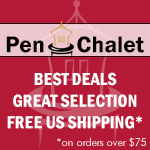Like many Kaweco fans, I’ve been anxiously awaiting the launch of the Kaweco Sport Piston Fountain Pen since they first announced it was in the works a year or two ago. Would it be a modern interpretation of one of their classic designs, or would it be a fully vintage inspired release?
Why not both?
In my head, I fully expected a plastic barrel piston-filler, sort of an upgraded, built out, Kaweco Sport, without a clip. What we got was a throwback exterior design with the Black barrel and Gold clip, but using Aluminum for construction, a more modern material. It’s a perfect combination of old and new, and a bit unexpected if I’m being honest.
As obvious as this is to state, the design is less important for this pen than the piston mechanism. It’s the reason it is being made, and it has to work well. In a smaller pen like this, that is always a question. Can the mechanism fit while retaining the desired barrel size? Does it operate smoothly? Does it allow for enough ink capacity as compared to a cartridge? Is the pen easy to clean? So far, the Sport Piston answers “Yes,” across the board.
The clip is easily removable if so desired.
To access the mechanism, Kaweco uses a blind cap that must be removed from the end of the barrel. Under the cap you will find the twist knob that activates the piston to draw up ink, or to expel water repeatedly when cleaning. The twist is a decent size - not too small to use comfortably - and the piston moves smoothly inside the barrel.
A vintage Kaweco Sport Piston, right.
My first draw from the ink bottle filled the ink chamber to around 75% capacity. That’s in the normal range. I could get closer to 100% if I drew up the ink, kept the nib submerged and expelled the ink, and drew up the ink again. That clears some of the air you get on the initial fill. YMMV.
You can check the ink capacity using the built in ink window, which I think is important for piston-filling pens. According to the product specs, the ink chamber can hold 1.2 ml of ink, while a short international ink cartridge holds 0.7 ml. That’s a decent increase for a pocket pen, with the caveat that a bottle of ink is required to refill it.
I ordered my Sport Piston with a Steel Extra Fine nib, and it is perfect for my handwriting. The ink flow from piston fillers is always something to watch, and this one is metered perfectly. I have yet to have any consistency issues in my lines, and I’ve been using this pen regularly for weeks, filled with Kaweco Royal Blue ink.
While my experiences with the Kaweco Sport Piston have been good so far, there are a few things to consider before purchasing:
— Price: This is an easy one to list first, because at $160 ($170 with a bottle of ink,) it is not a mindless purchase. Is it “worth it?” It is to me, but I’m a Kaweco fan, and was looking forward to this release for a while. Could they have lowered the cost if they used plastic/acrylic? Not by much I don’t think. I’m assuming much of the cost is on the inside of the pen, not the outside.
— Blind cap: There are two things to consider. One, people worry about losing the cap. Valid concern. Two, the blind cap can twist off inside of the pen cap when posted if you twist the pen cap itself when removing it from the back of the pen. It takes almost one and a half rotations to completely unthread the blind cap from the back of the pen, so it would take effort to cause this, but it is not out of the realm of possibility. I’ve had no issues so far, and don’t see this becoming a problem down the line.
— Grip: Out of these three considerations, this is the one I have to think about the most. When my fingers are dry, the satin finish of the aluminum barrel is slick. I need a little moisture to lock in my fingers for a more solid grip, and better writing experience. This is prone to happening with metal barrel pens, especially ones with a smooth grip like the Sport Piston.
Size comparison with LAMY Safari.
For their first piston mechanism release in decades, I think Kaweco did a great job. It’s a throwback design to when this filling system was part of their regular lineup, while bringing modern updates to the pen with the choice of barrel material. Hopefully this is a platform they continue building on because I see many different ways Kaweco can take the Sport Piston in the future.
(JetPens provided this product at no charge to The Pen Addict for review purposes.)
Enjoy reading The Pen Addict? Then consider becoming a member to receive additional weekly content, giveaways, and discounts in The Pen Addict shop. Plus, you support me and the site directly, for which I am very grateful.
Membership starts at just $5/month, with a discounted annual option available. To find out more about membership click here and join us!





























